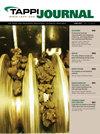硫酸盐漂白废水的生化甲烷势及其与其他厂内废水的共溶
IF 0.6
4区 农林科学
Q4 MATERIALS SCIENCE, PAPER & WOOD
引用次数: 2
摘要
通过生化甲烷电位测定,研究了硬木硫酸盐制浆漂白废水的厌氧消化率以及与纸浆造纸厂其他废水共消化的潜力。对四种厂内废水进行了单独和组合测试:总漂白废水、碱性漂白废水、硫酸盐蒸发器冷凝水和化学热力制浆废水。由二氧化氯漂白剂和碱性漂白剂组成的总漂白剂出水对有机物的降解和甲烷的生成潜力最大。化学需氧量(COD)去除率为57% ~ 76%,甲烷产生量为220 ~ 280 mL/g,取决于稀释程度。共消化试验表明,由总漂白出水、化学热力制浆出水和硫酸盐凝析液组成的复合液在COD去除率(51%)和甲烷生成(废水中COD含量为200 mL/g)方面效率最高。漂白废水总量是该工厂废水总量的最大贡献者;它含有相对低浓度的厌氧抑制剂,如可吸附的有机卤素(36 mg/L)、总硫(170 mg/L)、树脂和脂肪酸(3.2 mg/L)。因此,硬木硫酸盐制浆的全部漂白废水可考虑用于全面厌氧废水处理,要么作为单一流,要么作为包括其他厂内废水的复合流的一部分。本文章由计算机程序翻译,如有差异,请以英文原文为准。
Biochemical methane potential of kraft bleaching effluent and codigestion with other in-mill streams
A biochemical methane potential assay was conducted to investigate the anaerobic digestibility of bleaching effluent from hardwood kraft pulping and the potential of codigestion with other effluents from an integrated pulp and paper mill. Four in-mill streams were tested individually and in combination: total bleaching effluent, alkaline bleaching effluent, kraft evaporator condensate, and chemithermomechanical pulping effluent. The total bleaching effluent, consisting of the chlorine dioxide bleaching and alkaline bleaching effluents, exhibited the highest potential for organic matter degradation and methane generation. Chemical oxygen demand (COD) removal ranged from 57%-76%, and methane generation was 220-280 mL/g COD contained in the wastewater, depending on the degree of dilution. When codigestion was tested, the composite consisting of total bleaching effluent, chemithermomechanical pulping effluent, and kraft condensate was most efficient in terms of COD removal (51%) and methane generation (200 mL/g COD contained in the wastewater). The total bleaching effluent is the largest contributor to the overall amount of wastewater at this mill; it contains relatively low concentrations of anaerobic inhibitors such as adsorbable organic halogens (36 mg/L), total sulfur (170 mg/L), and resin and fatty acids (3.2 mg/L). Therefore, the total bleaching effluent from hardwood kraft pulping may be considered for full-scale anaerobic wastewater treatment, either as a singular stream or as part of a composite stream including other in-mill effluents.
求助全文
通过发布文献求助,成功后即可免费获取论文全文。
去求助
来源期刊

Tappi Journal
工程技术-材料科学:纸与木材
CiteScore
1.30
自引率
16.70%
发文量
59
审稿时长
6-12 weeks
期刊介绍:
An internationally recognized technical publication for over 60 years, TAPPI Journal (TJ) publishes the latest and most relevant research on the forest products and related industries. A stringent peer-review process and distinguished editorial board of academic and industry experts set TAPPI Journal apart as a reliable source for impactful basic and applied research and technical reviews.
Available at no charge to TAPPI members, each issue of TAPPI Journal features research in pulp, paper, packaging, tissue, nonwovens, converting, bioenergy, nanotechnology or other innovative cellulosic-based products and technologies. Publishing in TAPPI Journal delivers your research to a global audience of colleagues, peers and employers.
 求助内容:
求助内容: 应助结果提醒方式:
应助结果提醒方式:


